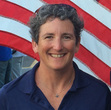Superstorm Sandy vs. The Perfect Storm: The Power of Prediction
I’ve been counting my blessings the past few days, as news reports and photos of Hurricane Sandy’s wrath trickle in from up and down the east coast. I don’t commute, so there’s no worry about flooded subways or washed out roads. And we never really lost power, thanks to the hill in the middle of our island that protected us from the worst easterly breeze on Monday.

1991′s Perfect Storm. Courtesy NOAA.
But even if we had lost power, we were well-prepared days ahead with a vast array of lanterns and candles, enough food to get us through, and a handy backup generator ready to go on the back porch.
That was not the case in 1991, when what quickly became known as the Perfect Storm tailed back toward Cape Cod in a completely unexpected u-turn. We’d been watching a late season hurricane named Grace spin along the coast, well offshore. Everyone assumed it would continue as usual on its merry way, north and east, until it reached water cold enough to sap its power—and then suddenly, it was aiming back at us. Just like Hurricane Sandy, Grace had been absorbed into a low pressure system that had formed off Nova Scotia. So instead of the seas subsiding, they built. Instead of the winds abating, they howled even harder. By the time we all realized this was “a big one,” it was already blowing a gale.

The Perfect Storm’s unexpected behavior, beginning with the low off Nova Scotia. Courtesy NOAA
I remember risking life and limb to get out to Felicity, my brother’s boat, which I was taking care of that year. She was riding happily on her mooring, all ready for her next sail. In spite of keeping a weather eye out I hadn’t seen this storm coming, so there I was in 40 knots of breeze stripping sails, securing what little was stored down below, and turning around for a last look back as I headed ashore, hoping she’d make it through.
Felicity made it through that storm fine, and she also made it through this latest Superstorm Sandy just fine. But the difference in the amount of time we had to prepare was striking. You’d have to have been living under a rock not to hear about the Frankenstorm ahead of time; a full week out meteorologists predicted it would hit almost exactly where and when it did end up coming ashore. Unfortunately for coastal New Jersey and New York City, there was little change in track in the days leading up to the storm; just a gradual tightening in the red swath that marked the projected path.

Sandy’s incredible size was only possible to grasp from a satellite. Courtesy NOAA
A ninety degree turn to the left? It looked so odd, which instantly recalled for me that strange feeling back in 1991 that the weather world was not behaving as expected. Only this time, the unexpected behavior was accurately predicted. It may not be much help to all the coastal residents looking at ruined houses and lives, but at least they had time to prepare.
Which is why the loss of the tall ship Bounty, along with two crewmembers, was so tragically avoidable. It seemed crazy for the crew to leave Connecticut heading for Florida with such a major storm predicted to rush up the coast. Cape Hatteras is a tough obstacle in any weather, and meeting a major hurricane head0n just off that coastline is just asking for trouble in any type of vessel. Apparently they thought they were safely east of the storm, which was larger than usual. But compared to the Andrea Gail, the fishing boat that sank in the Perfect Storm and inspired a book and a movie, the forecast information available to the skipper and crew of the Bounty was much, much more accurate.
Computer modeling has come a long way in twenty years. We now take for granted the information that predicts what’s coming, giving us the gift of time to plan accordingly. So maybe it’s time to stop making the weatherman the butt of all our jokes. Yes there was hype, and of course there was drama. But when it really mattered, they did a great job.



